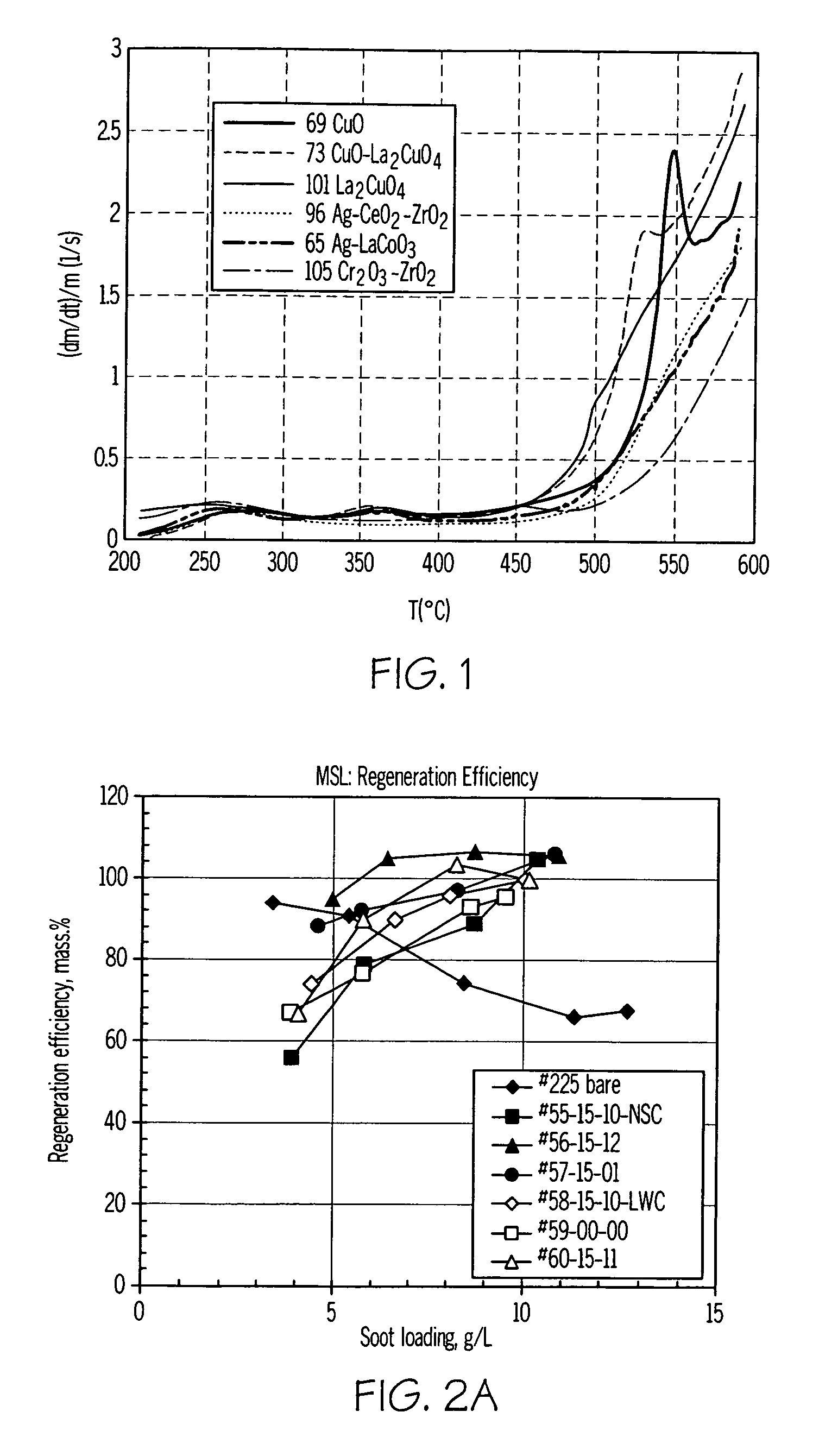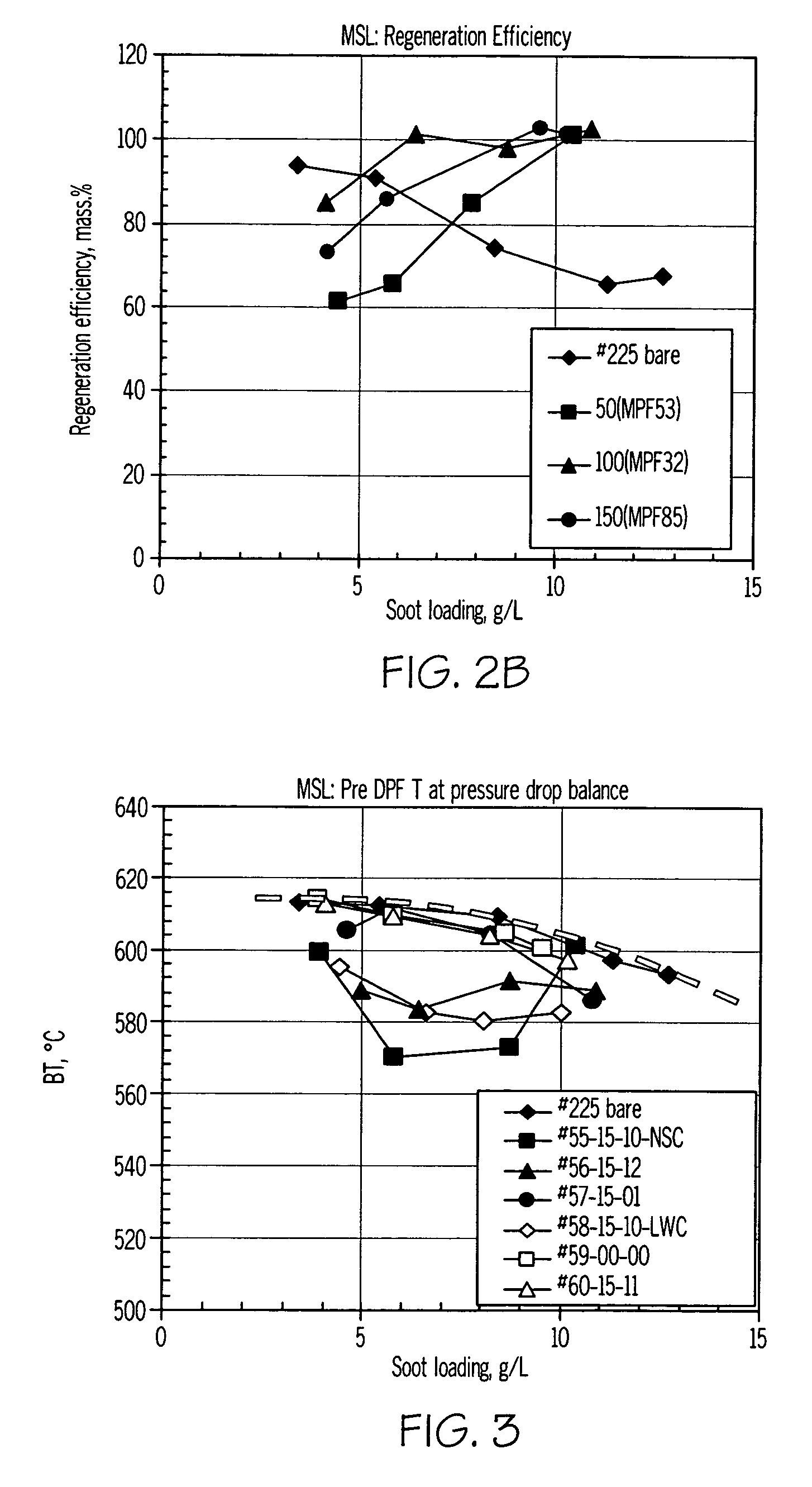Soot oxidation catalyst and method of making
a technology of oxidation catalyst and soot, which is applied in the field of catalyst composition, can solve the problems of difficult regeneration of filter by soot oxidation, unfavorable soot oxidation, and complex system, and achieve the effect of oxidizing soo
- Summary
- Abstract
- Description
- Claims
- Application Information
AI Technical Summary
Benefits of technology
Problems solved by technology
Method used
Image
Examples
example 1
Preparation of Catalyst Composition on Powder Samples
[0050]A catalyst composition was prepared in accordance with the present invention. A silicon carbide (SiC) powder was prepared by grinding commercial SiC square units to form a filter substrate material having a porosity of 60%. The SiC powder obtained was then sieved to obtain a fraction of 0.1 to 0.125 mm. This SiC powder was then coated with a solution containing alumina sol and saccharose (pure crystal sugar) and glycerol. The samples were dried 100° C. and calcined at 625° C. for 1 hour.
[0051]The alumina was then stabilized by impregnation with solutions of zirconyl acetate and lanthanum nitrate (3-5% La and 10-15% Zr; molar % of La and Zr to Al) followed by drying and calcining at 800° C. for 2 hours.
[0052]Next, the samples were impregnated with a water solution containing the catalyst precursor salts, i.e., copper nitrate, lanthanum nitrate, and citric acid and the precious metal precursors, e.g., silver nitrate, palladium...
example 2
Thermogravimetric and Flow Reactor Testing
[0053]Catalyst compositions prepared in accordance with the present invention were characterized using a thermogravimetric analysis-mass spectrometry (TGA-MS) method using a Hiden IGA-003 analyzer equipped with a mass spectrometer. In the procedure used, 240 mg of SiC powder with a deposited catalyst (20 wt % catalyst loading on powdered SiC (Ibiden) high porosity substrate) and 60 mg of real diesel soot were used. The catalyst / soot weight ratio was 4 / 1. Prior to testing, the catalyst and soot were mixed in a mortar with a spatula to provide loose contact between the catalyst and soot to simulate typical soot-catalyst content on a catalyzed filter. The samples were first heated in a reaction gas (6% O2—He; flow rate 100 cc / min) from 40° C. to 200° C. with a heating rate of 20° C. / min. and maintained at 200° C. for 20 minutes to remove all soluble organic fraction of soot (SOF), and then heated from 200° C. to 600° C. at 20° C. / min. After rea...
example 3
Coating Method for Filters
[0061]A number of porous substrates were coated with an alumina sol, a zirconia sol, or a silica sol containing various amounts of glycerol and / or saccharose. The BET surface areas of the coated substrates were then measured by N2 adsorption at 77K using Micromeritics 2010 ASAP equipment. The results are shown below in Table 2.
[0062]
TABLE 2Number ofSubstrate / Coatingcoatingsporosity (%)BET, m2 / g20% alumina sol1Cordierite - 65%2420% alumina sol2Cordierite - 65%3120% alumina sol + glycerol1Cordierite - 65%3220% alumina sol + saccharose1Cordierite - 65%2920% alumina sol +1Cordierite - 65%37glycerol + saccharose20% alumina sol +2Cordierite - 65%56glycerol + saccharose30% silica sol1Cordierite - 65%3130% silica sol +1Cordierite - 65%40glycerol + saccharose20% zirconia sol1Cordierite - 65%720% zirconia sol +1Cordierite - 65%12glycerol + saccharose20% alumina sol1SiC - 60%1920% alumina sol +1SiC - 60%30glycerol + saccharose20% alumina sol1Composite - 85%5420% alumi...
PUM
| Property | Measurement | Unit |
|---|---|---|
| temperature | aaaaa | aaaaa |
| temperature | aaaaa | aaaaa |
| temperatures | aaaaa | aaaaa |
Abstract
Description
Claims
Application Information
 Login to View More
Login to View More - R&D
- Intellectual Property
- Life Sciences
- Materials
- Tech Scout
- Unparalleled Data Quality
- Higher Quality Content
- 60% Fewer Hallucinations
Browse by: Latest US Patents, China's latest patents, Technical Efficacy Thesaurus, Application Domain, Technology Topic, Popular Technical Reports.
© 2025 PatSnap. All rights reserved.Legal|Privacy policy|Modern Slavery Act Transparency Statement|Sitemap|About US| Contact US: help@patsnap.com



